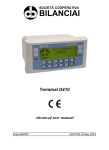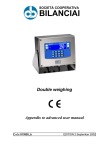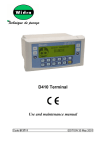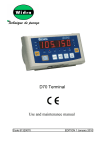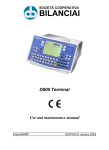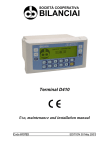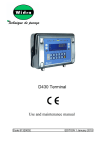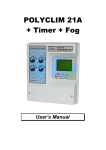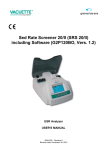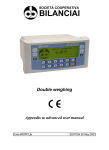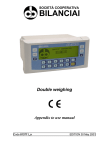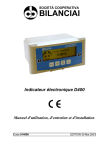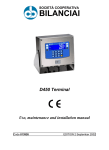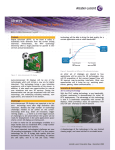Download D450
Transcript
SOCIETÀ COOPERATIVA
BILANCIAI
Terminal D450
Advanced user manual
Code 813920
EDITION 2 September 2002
D450
Index
9. FOREWORD TO THE ADVANCED USER MANUAL
2-7
10. PROGRAMMING OF SERIAL LINE COMMUNICATION
2-9
10.1 Symbols used
2-9
10.2 Strings
2-10
10.2.1 Cb (or Bilanciai) string
2-10
10.2.2 Extended string
2-11
10.2.3 Extraction string
2-13
10.2.4 Visual string
2-14
10.2.5 Idea string
2-15
10.2.6 Cma
2-15
10.2.7 On request with address
2-15
10.2.8 Customized string
2-16
10.3 Protocols for cyclic strings
2-17
10.3.1 ACK-NAK protocol
2-17
10.3.2 Cyclic protocol
2-17
10.3.3 On request protocol
2-17
10.4 Remote commands protocol
2-18
10.4.1 Response times
2-19
10.4.2 Reply to an incorrect command
2-20
10.4.3 Reply to a correct command
2-20
10.4.4 Suspension of cyclic transmission
2-20
10.4.5 Resumption of cyclic transmission
2-20
10.4.6 Request for gross weight
2-20
10.4.7 Request for net weight
2-21
10.4.8 Request transmission of tare
2-21
10.4.9 Request transmission of scale status
2-21
10.4.10 Request transmission of scale status (version EV2001)
2-23
10.4.11 Scale zeroing
2-23
10.4.12 Tare acquisition
2-23
10.4.13 Tare entering
2-23
10.4.14 Cancellation of an entered tare
2-24
10.4.15 Request transmission of general data table
2-24
10.4.16 Request for general data item "n"
2-24
10.4.17 Request to enter the value "y" in the general data item "n"
2-25
10.4.18 Request for transmission of the net weight and the scale status 2-25
10.4.19 Request for transmission of net weight and scale status with 6
bytes
2-26
10.4.20 Request for transmission of the net weight, tare and scale status
with 6 bytes
2-27
10.4.21 Print request
2-27
10.4.22 Read last weight acquired
2-27
10.4.23 Cancel last acquired weight
2-27
10.4.24 Request division value
2-28
10.4.25 Request for net weight in high resolution
2-28
10.4.26 Request for maximum capacity value
2-28
10.4.27 Request for net weight without unit of measurement
2-28
10.4.28 Lock keypad and display
2-29
10.4.29 Unlock keypad and display
2-29
2-3
D450
10.4.30 Lock keypad
2-29
10.4.31 Unlock keypad
2-29
10.4.32 Remote commands with checksum
2-29
10.4.33 Remote commands with addressing
2-31
10.5 Remote commands for Input/Output management
2-32
10.5.1 How to set a single output
2-32
10.5.2 How to zero-set a single output
2-33
10.5.3 How to test a single output
2-34
10.5.4 How to test a single input
2-35
10.5.5 How to test all the outputs
2-36
10.5.6 How to change the status of all the outputs
2-38
10.5.7 How to test all the inputs
2-39
10.6 Remote commands for digital cells
2-40
10.6.1 Request for cell points
2-40
10.6.2 Request for cell temperature
2-40
10.6.3 Request for version and release of cell software
2-40
10.6.4 Request for power supply
2-41
10.6.5 Request for cell serial numbers
2-41
10.6.6 Request for angle calibration coefficient
2-41
10.6.7 Request for number of cells in system
2-42
10.6.8 Request for cell status
2-42
10.6.9 Request for digital scale status
2-44
10.7 Communication in MPP operation
2-46
10.7.1 Operation
2-46
10.7.2 Weighing request from keypad with data transmission on completion
of operation
2-47
10.7.3 Weighing request from serial command with transmission on
completion of operation
2-50
10.7.4 Weighing request from keypad and transmission request from serial
command
2-50
10.7.5 Weighing and transmission request from serial command
2-51
10.7.6 MP and MC remote commands with checksum
2-51
11. PERSONALIZATION
11.1 Foreword
11.2 Accessing the parameter configuration function
11.3 Language
11.4 Setup menu
11.4.1 Conditioned menu
11.4.2 Entering numeric data
11.4.3 Entering alphanumeric data
11.4.4 Validating input data
11.4.5 NOT MODIFIABLE parameter or menu
11.4.6 NOT AVAILABLE parameter or menu
11.5 Overview of the menu tree
11.6 Descriptions of the main menus and parameters
11.6.1 Setup Menu/Scale/Configurations/Metrological
11.6.2 Setup Menu/Scale/Configurations/General menu
11.6.3 Setup Menu/ANALOGUE scale/Analogue scale parameters
11.6.4 Setup Menu/DIGITAL scale/Digital scale parameters
11.6.5 Setup Menu/Scale/Calibration/Display data
11.6.6 Setup Menu/Scale/Test
2-4
2-53
2-53
2-53
2-53
2-54
2-54
2-54
2-54
2-54
2-55
2-55
2-55
2-58
2-58
2-59
2-60
2-60
2-60
2-61
D450
11.6.7 Setup Menu/Personalizations/Operating modes
2-63
11.6.8 Setup Menu/Personalizations/Operating modes /Printer/ Model 2-65
11.6.9 Setup Menu/Personalizations/Operating modes /Printer/ Port
2-69
11.6.10 Setup Menu/Personalizations/Operating modes/ Printer / Prints 2-70
11.6.11 Setup Menu/Personalizations/Operating modes/MPP operation 2-72
11.6.12 Setup Menu/Personalizations/Operating modes/Traffic light
2-73
11.6.13 Setup Menu/Personalizations/Outputs/Serial/Com xy
2-74
11.6.14 Setup Menu / Personalizations / Outputs / Serial / String /.../ Com xy
configuration
2-76
11.6.15 Setup Menu/Personalizations/Outputs/Input-Output
2-77
11.6.16 Setup Menu/Personalizations/Outputs/Analogue output
2-80
11.6.17 Setup Menu/Personalizations/Outputs/BCD
2-80
11.6.18 Setup Menu/Personalizations/Messages
2-81
11.6.19 List of modifiable messages
2-82
11.6.20 Setup Menu/Personalizations/Shortcut keys
2-85
11.6.21 Setup Menu/Personalizations/Texts
2-87
11.6.22 Setup Menu/Personalizations/Files
2-88
11.6.23 Setup Menu/Personalizations/Prints-Customized transmis.
memorized
2-89
11.6.24 Setup Menu/Personalizations/Backup-Restore
2-90
11.7 Test procedures
2-93
11.7.1 Terminal Tests/Serial Ports
2-93
11.7.2 Terminal Tests/Inputs-Outputs
2-93
11.7.3 Terminal Tests/Keypad
2-93
11.7.4 Terminal Tests/Terminal Configuration Report
2-94
11.7.5 Terminal Tests/Analogue output
2-94
11.7.6 Terminal Tests/Battery
2-94
11.8 Repeater scale
2-95
11.8.1 Setup Menu/Repeater scale/Repeater scale parameters/Serial
port/Com xy
2-95
11.8.2 Setup Menu/Repeater scale/Repeater scale parameters/String 2-96
2-5
D450
2-6
D450
9. FOREWORD TO THE ADVANCED USER
MANUAL
This manual describes the procedures for terminal personalization in
order to adapt it to the specific weighing system in which it is installed.
It contains the software commands used to interface the terminal with a
PC, PLC and host computers in general.
WARNING
The personalization operations described herein do not in
any way influence weighing functions but, unless correctly
performed, they may compromise the operation of the
system as a whole. The operations described in this section
of the manual should only be entrusted to qualified
technicians with specialised experience in this field.
2-7
D450
2-8
D450
10. PROGRAMMING OF SERIAL LINE
COMMUNICATION
10.1 Symbols used
The following conventions are used to denote the characters used in
serial line communication.
✔ Normal characters are indicated with their usual symbols.
✔ Control characters appear in brackets and are written in uppercase.
For example:
<CR> indicates the carriage return character.
<SP> indicates the space character.
✔ Where necessary, the hexadecimal value of the character is given in
numbers and uppercase letters.
For example: <CR>(0DH) o $(24H).
✔ Variables are written in lower case between brackets.
For example:
<um>= unit of measurement.
This may assume the following values:
kg = kilogrammes
<SP>g = grammes
lb = pounds
<SP>t = tonnes
✔ Numeric fields are indicated with n and y, and may include initial
spaces, a decimal point and a minus sign.
2-9
D450
10.2 Strings
The terminal has two serial output ports which may be used for the
connection of external devices, such as printers, personal computers,
PLCs, etc.. The user can choose the type of transmission protocol to be
used from among those already present on the terminal. The user may
also personalize the serial transmission parameters using the specific
menu (see par. 11.6.14 on page 2-76).
10.2.1 Cb (or Bilanciai) string
1st character
$(24H)
start string character
2nd character
<s>
s=stability
s=0 weight stable
s=1 weight not stable
s=3 weight not valid (negative or
overload)
3rd-7th
character
8th character
net weight
if the weight consists of more than 5
digits, the least significant digits will
not be transmitted;
<CR>(ODH) end string character
The following protocols are available: Cyclic (see par. 10.3.2 on page
2-17), On request (see par. 10.3.3 on page 2-17), ACK-NAK (see par.
10.3.1 on page 2-17).
2-10
D450
10.2.2 Extended string
1st character
$(24H)
net weight with sign and decimal
point (if present)
2nd-10th
character
11th character
start string character
<SP>(20H)
space
tare with sign and decimal point (if
present)
12th-20th
character
21st character
<SP>(20H)
space
22nd-23rd
character
<um>
Unit of measurement
24th character
<SP>(20H)
space
25th character
<s1>
scale status
26th character
<s2>
scale status
27th character
<s3>
scale status
28th character
<s4>
scale status
29th character
<CR>(0DH)
30th character
<LF>(0AH)
The characters <s1>, <s2>, <s3>, <s4> are ASCII characters that must
be interpreted as hexadecimal values. Each character represents 4 bits
of different significance; for example, the incoming ASCII character "A"
must be interpreted as the hexadecimal digit "A";
1
0
1
0
bit3
bit2
bit1
bit0
2-11
D450
When a bit assumes the value "1" the corresponding signal is "true"; the
significance of the signals is as follows:
<s1>
<s2>
<s3>
<s4>
bit 0
minimum weighment signal
bit 1
tare locked signal
bit 2
tare preset(1)/self-weighed (0) entered signal
bit 3
centre zero signal
bit 0
LSB weighing extension signal (ME only)
bit 1
weight stable signal
bit 2
overload signal
bit 3
MSB weighing extension signal (ME only)
bit 0
tare entered signal
bit 1
tare locked cancelled signal (ME only)
bit 2
weight not valid
bit 3
printing in progress
bit 0
approved instrument
bit 1
converter fault
bit 2
scale configuration parameters error
bit 3
not utilised
The following protocols are available: Cyclic (see par. 10.3.2 on page
2-17), On request (see par. 10.3.3 on page 2-17), ACK-NAK (see par.
10.3.1 on page 2-17), Remote commands (see par. 10.4 on page 2-18).
2-12
D450
10.2.3 Extraction string
In the case of loading or unloading extraction operation, the net weight
and tare (2nd to 10th characters and 12th to 20th characters in the
Extended string) are replaced respectively by the extracted weight and
gross weight characters.
1st character
$(24H)
start string character
2nd-10th
character
0(30H)
extracted weight with sign and
decimal point (if present)
11th character
<SP>(20H)
space
gross weight with sign and decimal
point (if present)
12th-20th
character
21st character
<SP>(20H)
space
22nd-23rd
character
<um>
Unit of measurement
24th character
<SP>(20H)
space
25th character
<s1>
scale status (see note)
26th character
<s2>
scale status (see note)
27th character
<s3>
scale status (see note)
28th character
<s4>
scale status (see note)
29th character
<CR>(0DH)
30th character
<LF>(0AH)
2-13
D450
10.2.4 Visual string
1st character
$(24H)
start string character
2nd character
0(30H)
fixed zero character
3rd character
<s>
s=stability
s=0 weight stable
s=1 weight not stable
s=3 weight not valid (negative or
overload)
4th-8th
character
9th character
net weight with sign;
if the weight consists of more than 5
digits, the least significant digits will
not be transmitted;
if the value includes a decimal point,
the length of the string will be
increased by 1 character
<CR>(0DH) end string character
2-14
D450
10.2.5 Idea string
1st character
<cis>
cis=@(40H)
Start string character on pressing
cis=$(24H)
Start string character in other cases
2nd character
3rd-7th
character
8th character
<s>
s=stability
s=0 weight stable
s=1 weight not stable
s=3 weight not valid (negative or
overload)
net weight
if the weight consists of more than 5
digits, the least significant digits will
not be transmitted;
<CR>(ODH) end string character
10.2.6 Cma
Reserved string, not to be used. Further information supplied on
ordering.
10.2.7 On request with address
Selecting this option disables the transmission of cyclic strings.
Uses remote commands followed by terminal identification number (see
par. 10.4.33 on page 2-31).
2-15
D450
10.2.8 Customized string
The string format may be customized using the program "Dialogic".
For further information contact the Manufacturer.
2-16
D450
10.3 Protocols for cyclic strings
10.3.1 ACK-NAK protocol
The string is only sent on request of the user via the request
transmission key
or from an external input (see par. 11.6.15 on
page 2-77). After transmission of the weight, the terminal behaves as
follows:
✔ if it receives the "ACK" character (06H) , it awaits a new transmission
request;
✔ if it receives the "NAK" character (15H), it sends the string again
because the previous transmission was not completed successfully;
✔ if it receives three "NAK" characters in succession, the terminal
displays the "NO ACK" message (transmission error).
10.3.2 Cyclic protocol
The selected string (see par. 10.2 on page 2-10) is transmitted cyclically
at a rate of 3 times per second.
10.3.3 On request protocol
The selected string is transmitted:
✔ either on pressing the request transmission key
;
✔ or on the activation of an input (see par. 11.6.15 on page 2-77).
2-17
D450
10.4 Remote commands protocol
There are a number of serial line commands with which various
operations can be commanded from a remote device (PC, PLC etc.).
WARNING
Remote commands are only enabled if the extended string
format was selected during terminal configuration (see par.
10.2.2 on page 2-11).
WARNING
Remote commands are not executed if cyclic serial
transmission is in progress; in this case cyclic transmission
must be suspended with the command "EX<CR>" before
giving any other remote commands.
2-18
D450
10.4.1 Response times
Key
✔ CMD = Remote command
✔ ANS = Response to remote command
✔ tc = command time. Depends on the number of characters, the
number of bits per character and the baud rate.
E.g.: XB<CR>; with 3 characters, 8N1, 9600 then tc = 3,3ms
✔ trr = response delay time. It is always 2 characters or less.
E.g.: with 2 characters, 8N1, 9600 then trr <= 2,2ms
✔ tr = response time. Depends on the number of characters in the
response.
E.g.: if the response at XB<CR> is a string with 16 characters, 8N1,
9600 then tr = 17,6ms
✔ ta = waiting time between the end of the response and the beginning
of the next command. Must at least correspond to the time of 2
characters.
E.g.: with 2 characters, 8N1, 9600 then ta >= 2,2ms
Figure 10.1 - Response times (citi0614.jpg)
2-19
D450
10.4.2 Reply to an incorrect command
??<CR><LF>
This reply string is sent:
✔ if the command syntax is incorrect;
✔ if the command cannot be executed.
10.4.3 Reply to a correct command
In the case of the command being accepted, if the command requests
the transmission of information, the reply will consist of the transmission
of the requested data item; in other cases the reply will consist of the
following string:
OK<CR><LF>
10.4.4 Suspension of cyclic transmission
This command is not available with the RS485 protocol, in which
transmission is on request only
EX<CR>
10.4.5 Resumption of cyclic transmission
This command is not available with the RS485 protocol, in which
transmission is on request only
SX<CR>
10.4.6 Request for gross weight
XB<CR>
The terminal responds with the following string:
n<SP><um><SP>B<CR><LF>
n = 9 characters (see par. 10.1 on page 2-9).
2-20
D450
10.4.7 Request for net weight
XN<CR>
The terminal responds with the following string:
n<SP><um><SP>NT<CR><LF>
n = 9 characters (see par. 10.1 on page 2-9).
10.4.8 Request transmission of tare
XT<CR>
The terminal responds with the following string:
n<SP><um><SP>TE<CR><LF>
if the tare has been entered manually;
n<SP><um><SP>TR<CR><LF>
if the tare has been acquired.
n = 9 characters (see par. 10.1 on page 2-9).
10.4.9 Request transmission of scale status
XZ<CR>
The terminal responds with the following string:
<s1><s2><s3><s4><CR><LF>
The characters s1, s2, s3 and s4 are ASCII characters which must be
interpreted as hexadecimal values. Each character represents 4 bits of
different significance; for example, the incoming ASCII character "A"
must be interpreted as the hexadecimal digit "A";
1
0
1
0
bit3
bit2
bit1
bit0
2-21
D450
When a bit assumes the value "1" the corresponding signal is "true"; the
significance of the signals is as follows:
<s1>
<s2>
<s3>
<s4>
bit 0
minimum weighment signal
bit 1
tare locked signal
bit 2
tare preset(1)/self-weighed (0) entered signal
bit 3
centre zero signal
bit 0
LSB weighing extension signal (ME only)
bit 1
weight stable signal
bit 2
overload signal
bit 3
MSB weighing extension signal (ME only)
bit 0
tare entered signal
bit 1
tare locked cancelled signal (ME only)
bit 2
weight not valid
bit 3
printing in progress
bit 0
approved instrument
bit 1
converter fault
bit 2
scale configuration parameters error
bit 3
not utilised
2-22
D450
10.4.10 Request transmission of scale status (version
EV2001)
XS<CR>
In the case of a positive reply, the terminal responds with the following
string:
<s1><s2><CR><LF>
The characters s1 and s2 are ASCII characters that must be interpreted
as hexadecimal values.
The bits indicate the scale status as follows.
<s1>
<s2>
bit 0
in range
bit 1
weight stable
bit 2
centre zero
bit 3
displayed net weight
bit 0
not utilised
bit 1
not utilised
bit 2
not utilised
bit 3
print request: the print key has been pressed or
input n° 3 is activated.
10.4.11 Scale zeroing
AZ<CR>
10.4.12 Tare acquisition
AT<CR>
10.4.13 Tare entering
nAT<CR>
The command AT must be preceded by a weight expressed in a
maximum of 7 characters comprising the decimal point, if present.
2-23
D450
10.4.14 Cancellation of an entered tare
CT<CR>
This command cancels any tare value in memory.
10.4.15 Request transmission of general data table
ND<CR>
The terminal responds to this command with a sequence of strings
terminating in <CR><LF> each containing the number of the data item
and its description; the following is an example data table:
1 Date
2 Time
3 Extracted
4 Gross
5 Tare
6 Net
7 Status
8 ...
9 ...
The value of the general data in the table can be recalled and set up
with the remote commands described in par. 10.4.16 on page 2-24 and
par. 10.4.17 on page 2-25.
10.4.16 Request for general data item "n"
Xln<CR>
With this command it is possible to read the current value of any of the
general data.
2-24
D450
10.4.17 Request to enter the value "y" in the general data item
"n"
yXln<CR>
where "y" is the value you wish to assign to the data item "n". Obviously
the value to be entered must conform to the format of the data item.
Values for some of the general data cannot be entered (e.g. gross
weight, net weight, scale status, date, time, totals, etc.).
10.4.18 Request for transmission of the net weight and the
scale status
Xn<CR>
N.B.: the command sent is comprised of an uppercase X and lowercase
n (not to be confused with generic significance assigned to the
lowercase n described in par. 10.1 on page 2-9).
In the case of a positive reply, the terminal responds with the following
string:
n<SP><um><SP><s1><s2><s3><s4><CR><LF>
n = 9 characters (see par. 10.1 on page 2-9).
The characters s1, s2, s3 and s4 are ASCII characters the meaning of
which is explained in par. 10.4.9 on page 2-21.
2-25
D450
10.4.19 Request for transmission of net weight and scale
status with 6 bytes
YS<CR>
When the command is received, the terminal replies with the following
string:
n<SP><um><SP><s1><s2><s3><s4><s5><s6><CR><LF>
n = 9 characters (see par. 10.1 on page 2-9).
The meaning of the <s1>, <s2>, <s3> and <s4> bits is described in par.
10.4.9 on page 2-21.
The meaning of the <s5> and <s6> bits is as follows:
<s5>
<s6>
bit 0
not utilised
bit 1
not utilised
bit 2
battery low indication
bit 3
Print made, weight acquired
bit 0
tare changed
bit 1
not utilised
bit 2
not utilised
bit 3
not utilised
The bit2 of <s5> is zero-set immediately after the 6 byte status
transmission.
The bit3 of <s5> is zero-set immediately after the CP remote command
has been received (par. 10.4.23 on page 2-27). You can read the last
weight acquired by means of the PA command (par. 10.4.22 on page
2-27).
The bit0 of <s6> is zero-set after the response has been transmitted to
remote command XT (par. 10.4.8 on page 2-21) or YT (par. 10.4.20 on
page 2-27).
Remember that in multi-expansion terminals, the tare is rounded off to
the extension change but the changed tare bit is not altered (the
operator must ask for the tare whenever the extension changes; this
change can be checked through bit0 and bit3 of <s2>).
2-26
D450
10.4.20 Request for transmission of the net weight, tare and
scale status with 6 bytes
YT<CR>
When the command is received, the terminal replies with the following
string:
n<SP>y<SP><um><SP><s1><s2><s3><s4><s5><s6><CR><LF>
where:
n = net weight; n = 9 characters (see par. 10.1 on page 2-9)
y = tare; y = 9 characters (see par. 10.1 on page 2-9)
The meaning of the <s1>, <s2>, <s3>, <s4>, <s5> and <s6> bits has
been described previously (par. 10.4.19 on page 2-26 and par. 10.4.9 on
page 2-21).
10.4.21 Print request
PR<CR>
Any "printing not performed" message will be signalled only on the
display.
10.4.22 Read last weight acquired
PA<CR>
The terminal responds by sending the last net weight to be acquired by
pressing the print key or in response to the remote command PR; the
reply string is as follows:
n<SP><um><SP>PA<CR><LF>
n = 9 characters (see par. 10.1 on page 2-9).
10.4.23 Cancel last acquired weight
CP<CR>
2-27
D450
10.4.24 Request division value
Xe<CR>
The terminal responds with the string:
e= n<SP><um><CR><LF>
10.4.25 Request for net weight in high resolution
YN<CR>
The reply string is:
n<SP>y<SP><um><SP><s1><s2><s3><s4><CR><LF>
n= net weight; n = 9 characters (see par. 10.1 on page 2-9)
y= net weight in high resolution; y = 10 characters (see par. 10.1 on
page 2-9)
s1,s2,s3,s4=see STATUS in extended string (par. 10.2.2 on page 2-11).
10.4.26 Request for maximum capacity value
XM<CR>
The reply string is:
Max= n<SP><um><CR><LF>
n = 9 characters (see par. 10.1 on page 2-9).
10.4.27 Request for net weight without unit of measurement
YP<CR>
The reply string is:
n<CR><LF>
where:
n= significant digits of weight only
This string does not include the unit of measurement and insignificant
leading zeroes are not transmitted.
2-28
D450
10.4.28 Lock keypad and display
LD<CR>
The message "DISPLOCK" is displayed in place of the weight and all
keys are disabled.
10.4.29 Unlock keypad and display
UD<CR>
The keypad and display are re-enabled.
10.4.30 Lock keypad
LK<CR>
Only the keypad is locked and the terminal displays the message
"KEYLOCK".
10.4.31 Unlock keypad
UK<CR>
The keypad is unlocked.
10.4.32 Remote commands with checksum
Management of remote commands with checksum can be enabled
during the installation phase (par. 11.6.13 on page 2-74).
Checksum mode increases security when the terminal and PC dialogue
with each other since the following precautions are taken:
✔ each remote command transmitted to the terminal must contain two
checksum characters in a dedicated position;
✔ each reply with data that the terminal transmits to the PC after a
remote command must contain two checksum characters in a
dedicated position.
The position of the two checksum characters is immediately prior to the
<CR> character..
Checksum calculation involves making the XOR (exclusive OR) of all the
characters in the string up to the first checksum character excluded. The
result is expressed by two hexadecimal characters.
2-29
D450
An example of a gross weight transmission with checksum is given
below:
XB chk1chk2 <CR>
where, supposing that value 1A is obtained from XOR:
chk1 is the first checksum character ("1" or rather 31H)
chk2 is the second checksum character ("A" or rather 41H).
The terminal replies with the following string:
n<SP><um><SP>B chk1chk2 <CR><LF>
n = 9 characters (see par. 10.1 on page 2-9).
2-30
D450
10.4.33 Remote commands with addressing
When using the string "On request with address" or if the RS485
communication interface is selected, the remote commands described in
par. 10.4 on page 2-18 will also have to include the number of the
terminal to be interrogated.
The system is comprised of one Master terminal (e.g. a PC) and a
number of Slave terminals (e.g. weighing terminals).
Each weighing terminal is identified by a unique "terminal number" (see
par. 11.6.13 on page 2-74).
In this way you can create a network of weighing terminals that can be
interrogated by the Master terminal.
The syntax of the remote commands has to be modified by the addition
of the two characters of the terminal number.
For example, the gross weight transmission command XB <CR>
becomes XB 01 <CR> to indicate that the request from the Master
terminal is addressed to the terminal number 01.
Similarly, in checksum mode the gross weight transmission command
becomes XB01 chk1 chk2 <CR>.
No reply will be sent by the terminal if there are checksum errors.
2-31
D450
10.5 Remote commands for Input/Output management
10.5.1 How to set a single output
Output n2 of slot n1 can be set by means of the following command:
SO n1 n2 <CR>
where:
n1 is 1 hexadecimal character that defines the slot position of the output;
n2 is 1 hexadecimal character that defines the number of the output on
slot n1.
n1 = 0 (30H) output on the terminal
n1 = 1 (31H) output on slot 1
n1 = 2 (32H) output on slot 2
n2 = 1 (31H) output number 1
n2 = 2 (32H) output number 2
n2 = 3 (33H) output number 3
n2 = 4 (34H) output number 4
2-32
D450
10.5.2 How to zero-set a single output
Output n2 of slot n1 can be zero-set by means of the following
command:
RO n1 n2 <CR>
where:
n1 is 1 hexadecimal character that defines the slot position of the output;
n2 is 1 hexadecimal character that defines the number of the output on
slot n1.
n1 = 0 (30H) output on the terminal
n1 = 1 (31H) output on slot 1
n1 = 2 (32H) output on slot 2
n2 = 1 (31H) output number 1
n2 = 2 (32H) output number 2
n2 = 3 (33H) output number 3
n2 = 4 (34H) output number 4
2-33
D450
10.5.3 How to test a single output
The status of each output can be requested by means of the following
command:
TO n1 n2 <CR>
where:
n1 is 1 hexadecimal character that defines the slot position of the output;
n2 is 1 hexadecimal character that defines the number of the output on
slot n1.
n1 = 0 (30H) output on the terminal
n1 = 1 (31H) output on slot 1
n1 = 2 (32H) output on slot 2
n2 = 1 (31H) output number 1
n2 = 2 (32H) output number 2
n2 = 3 (33H) output number 3
n2 = 4 (34H) output number 4
The terminal replies with one of the following messages:
✔ 1<CR><LF> if the output is activated;
✔ 0<CR><LF> if the output is not activated;
✔ -<CR><LF> if there is no slot.
2-34
D450
10.5.4 How to test a single input
The status of each input can be requested by means of the following
command:
TI n1 n2 <CR>
where:
n1 is 1 hexadecimal character that defines the slot position of the input;
n2 is 1 hexadecimal character that defines the number of the input on
slot n1.
n1 = 0 (30H) input on the terminal
n1 = 1 (31H) input on slot 1
n1 = 2 (32H) input on slot 2
n2 = 1 (31H) input number 1
n2 = 2 (32H) input number 2
n2 = 3 (33H) input number 3
n2 = 4 (34H) input number 4
The terminal replies with one of the following messages:
✔ 1<CR><LF> if the input is activated;
✔ 0<CR><LF> if the input is not activated;
✔ -<CR><LF> if there is no slot.
2-35
D450
10.5.5 How to test all the outputs
The status of all the slot outputs can be requested by means of the
following command:
LO<CR>
The terminal replies with the following string:
n1n2n3<CR><LF>
where:
n1 is 1 character that is the logic combination of the status (0 or 1) of the
outputs (max. 2) on the terminal. Its values can be 0 0 (30H) to 3 (33H).
n2 is 1 character that is the logic combination of the status (0 or 1) of the
outputs (max. 4) on slot 1. Its values can be 0 (30H) to F (46H). If there
is no slot 1, the value of n2 will be " - " (2DH).
n3 is a character that is the logic combination of the status (0 or 1) of the
outputs (max. 4) on slot 2. Its values can be 0 (30H) to F (46H). If there
is no slot 1, the value of n2 will be " - " (2DH).
The lines will be arranged in the following way:
bit3
bit2
bit1
bit0
line 4
line 3
line 2
line 1
where the values of the lines are 0 or 1.
For example, if the following command is received:
184<CR><LF>
1
8
4
01
1000
0100
2-36
D450
where:
01 lines on slot 1: line 1 activated (bit 0 = 1), line 2 (bit 1 = 0) not
activated;
1000 lines on terminal: line 1 (bit 0 = 0), 2 (bit 1 = 0), 3 (bit 2 = 0) not
activated, line 4 (bit = 1) activated;
0100 lines on slot 2: line 1 (bit 0 = 0), 2 (bit 1 = 0), 4 (bit 3 = 0) not
activated, line 3 (bit 2 = 1) activated.
2-37
D450
10.5.6 How to change the status of all the outputs
The status of all the slot outputs can be changed by means of the
following command:
n1n2n3WO<CR>
where:
n1 is 1 character that is the logic combination of the status (0 or 1) of the
outputs (max. 2) on the terminal. Its values can be 0 (30H) to 3 (33H).
n2 is 1 character that is the logic combination of the status (0 or 1) of the
outputs (max. 4) on slot 1. Its values can be 0 (30H) to F (46H).
n3 is a character that is the logic combination of the status (0 or 1) of the
outputs (max. 4) on slot 2. Its values can be 0 (30H) to F (46H).
2-38
D450
10.5.7 How to test all the inputs
The status of all the slot inputs can be requested by means of the
following command:
LI<CR>
The terminal replies with the following string:
n1n2n3<CR><LF>
where:
n1 is 1 character that is the logic combination of the status (0 or 1) of the
inputs (max. 2) on the terminal. Its values can be 0 (30H) to 3 (33H).
n2 is 1 character that is the logic combination of the status (0 or 1) of the
inputs (max. 4) on slot 1. Its values can be 0 (30H) to F (46H). If there is
no slot 1, the value of n2 will be " - " (2DH).
n3 is a character that is the logic combination of the status (0 or 1) of the
inputs (max. 4) on slot 2. Its values can be 0 (30H) to F (46H). If there is
no slot 1, the value of n2 will be " - " (2DH).
2-39
D450
10.6 Remote commands for digital cells
The following conventions will now be used besides the symbols already
given in par. 10.1 on page 2-9:
✔ c number that identifies the digital cell;
✔ n and m indicate numerical fields with possible spaces at the
beginning, decimal separator, - sign and + sign.
10.6.1 Request for cell points
DPc<CR>
The terminal replies with this string:
n<CR><LF>
n = number of points (0 to 200000)
10.6.2 Request for cell temperature
DTc<CR>
The terminal replies with this string:
n<CR><LF>
n = cell temperature in °C (- 40.0 to 100.0)
10.6.3 Request for version and release of cell software
DVc<CR>
The terminal replies with this string:
n<SP>m<CR><LF>
n = cell software version
m = cell software release
2-40
D450
10.6.4 Request for power supply
DAc<CR>
The terminal replies with this string:
n<SP>m<CR><LF>
n = cell power supply voltage rating;
m = strain gauge power supply voltage rating.
10.6.5 Request for cell serial numbers
DMc<CR>
The terminal replies with this string:
n<SP>m<CR><LF>
n = cell serial number recorded on the cell
m = cell serial number recorded on the terminal
10.6.6 Request for angle calibration coefficient
DCc<CR>
The terminal replies with this string:
n<SP>m<CR><LF>
n = angle calibration coefficient loaded in cell
m = angle calibration coefficient loaded in terminal
n and m can also take on the exponential format in this case.
2-41
D450
10.6.7 Request for number of cells in system
DN<CR>
The terminal replies with this string:
n<CR><LF>
n = number of cells that form the system
10.6.8 Request for cell status
DSc<CR>
The terminal replies with this string:
<s1><s2><s3><s4><CR><LF>
Characters s1, s2, s3, s4 are ASCII characters that must be interpreted
as hexadecimal value. Each character represents 4 bits with different
meanings. For example, the ASCII "A" character on the input must be
interpreted as hexadecimal figure "A":
1
0
1
0
bit3
bit2
bit1
bit0
2-42
D450
When the value of a bit is "1", this means that the corresponding signal
is in the true status. The meaning of the signals is as follows:
<s1>
<s2>
<s3>
<s4>
bit 0
temperature error
bit 1
not utilised
bit 2
not utilised
bit 3
not utilised
bit 0
cell not connected
bit 1
cell not configured
bit 2
serial number error
bit 3
voltage error
bit 0
reserved
bit 1
reserved
bit 2
not utilised
bit 3
cell in warm up status
bit 0
offset
bit 1
temperature reading phase
bit 2
voltage reading phase
bit 3
calibration reading phase
2-43
D450
10.6.9 Request for digital scale status
DB<CR>
The terminal replies with this string:
<s1><s2><s3><s4><CR><LF>
Characters s1, s2, s3, s4 are ASCII characters that must be interpreted
as hexadecimal value. Each character represents 4 bits with different
meanings. For example, the ASCII "A" character on the input must be
interpreted as hexadecimal figure "A":
1
0
1
0
bit3
bit2
bit1
bit0
2-44
D450
When the value of a bit is "1", this means that the corresponding signal
is in the true status. The meaning of the signals is as follows:
<s1>
<s2>
<s3>
<s4>
bit 0
not utilised
bit 1
not utilised
bit 2
not utilised
bit 3
not utilised
bit 0
voltage error in a cell
bit 1
not utilised
bit 2
not utilised
bit 3
not utilised
bit 0
at least one cell with temperature value off-range
bit 1
new system
bit 2
scale board replaced
bit 3
one single cell in multiple cell system replaced
bit 0
at least one cell not connected
bit 1
at least one cell not configured
bit 2
at least one cell with serial number error
bit 3
cell power supply voltage error
2-45
D450
10.7 Communication in MPP operation
10.7.1 Operation
Terminals equipped with the MPP option can operate in the four different
modes described in the following paragraphs.
The operating mode used for MPP memory operation is selected during
installation (par. 11.6.11 on page 2-72).
2-46
D450
10.7.2 Weighing request from keypad with data transmission
on completion of operation
After having enabled the MPP memory (consult the Options chapter of
the user manual), load the weight onto the scale, wait for weight stable
signal, then press
.
The terminal will save the weight data in memory and then transmit
them.
If the Standard item has been selected in the Setup Menu (par.
11.6.11 on page 2-72), the data transmitted are:
1st character
$(24H)
2nd character
M(4DH)
3rd character
P(50H)
4th-10th
character
MPP identification code or scale
status indications:
NO<SP>STAB weight not stable
NO<SP>VAL<SP> weight not valid
ERRMEM<SP> weight
memorisation error
11th-18th
character
Weight with sign and decimal point,
if present
19th-20th
character
<um>
Unit of measurement
21st-22nd
character
<CRC>
String check field; calculated by
performing an XOR operation
(exclusive OR) of all the preceding
characters. The value calculated is
expressed in two hexadecimal
characters, e.g. if the result is 62H,
the two checksum characters are
"6" (36H) and "2" (32H).
2-47
D450
If the Terminal number item has been selected in the Setup Menu
(par. 11.6.11 on page 2-72), the data transmitted are:
1st character
$(24H)
2nd character
M(4DH)
3rd character
P(50H)
4th-6th character
MPP terminal number
7th-13th
character
MPP identification code or
indications about the scale status:
NO<SP>STAB weight not stable
NO<SP>VAL<SP> weight not valid
ERRMEM<SP> weight memorizing
error
14th-21st
character
Weight with sign and possibly a
decimal separator
22nd-23rd
character
<um>
Unit of measurement
24th-25th
character
<CRC>
String monitoring field.
2-48
D450
If the Serial Number item has been selected in the Setup Menu
(par. 11.6.11 on page 2-72), the data transmitted are:
1st character
$(24H)
2nd character
M(4DH)
3rd character
P(50H)
4th-11th
character
Serial number
12th-18th
character
MPP identification code or
indications about the scale status:
NO<SP>STAB weight not stable
NO<SP>VAL<SP> weight not valid
ERRMEM<SP> weight memorizing
error
19th-26th
character
Weight with sign and possibly a
decimal separator
27th-28th
character
<um>
Unit of measurement
29th-30th
character
<CRC>
String monitoring field.
The computer replies with:
✔ <ACK> if the string has arrived correctly;
✔ <NAK> if the string has not arrived correctly; in which case the
terminal retransmits the data packet. After three negative replies or
no reply, the terminal displays an error message.
Any characters other than <ACK> and <NAK> are interpreted as
<NAK>.
WARNING
The ACK/NACK protocol (see par. 10.3.1 on page 2-17) is
automatically enabled in MPP operation.
2-49
D450
10.7.3 Weighing request from serial command with
transmission on completion of operation
After having loaded the weight on the scale, send the memorise weight
and data request command via the computer:
MP<CR>
If the response is affirmative, the terminal will transmit one of the strings
described in par. 10.7.2 on page 2-47 in the same mode, depending on
the item selected in the Setup menu (Standard, Terminal number, Serial
number).
10.7.4 Weighing request from keypad and transmission
request from serial command
After loading the weight on the scale, wait for the weight stable indication
and then press
; the terminal will memorise the data.
The computer may request the weight data from the terminal with the
command:
MP<CR>
The weighing terminal replies:
✔ with one of the strings described in par. 10.7.2 on page 2-47;
✔ NP<CR><LF>
if no weight has been memorised;
The data may requested more than once with the command MP<CR>.
At the end of the operation, the computer must transmit the command to
enable the terminal to carry out a new weighing operation:
MC<CR>
2-50
D450
10.7.5 Weighing and transmission request from serial
command
After loading the weight on the scale, send the memorise weight
command from the computer:
MP<CR>
Once the weight validity conditions are satisfied, the terminal memorises
the data.
The external computer must then transmit the data request command:
MP<CR>
The terminal responds with the string described in par. 10.7.2 on page
2-47.
10.7.6 MP and MC remote commands with checksum
Remote commands MP and MC modify their structure for entry of the
checksum characters. Their format becomes the one below:
MP 1 D <CR>
MC 0 E <CR>
2-51
D450
2-52
D450
11. PERSONALIZATION
11.1 Foreword
WARNING
Personalization procedures are strictly reserved for
specialised personnel only.
However, the user is permitted to modify certain of the
terminal operating parameters.
We recommend that extreme care is taken when modifying
these parameters to prevent possible malfunctions caused
by incorrect settings.
The only parameters that may be modified are those directly
related to the program installed on the terminal.
11.2 Accessing the parameter configuration function
To access non-metrological parameters only:
✔ press
on switching on the terminal.
11.3 Language
On entering setup, you can select the language in which you want the
menu to be displayed.
After selecting the setup menu language, the following information is
briefly displayed:
✔ program code
✔ version
✔ serial number of terminal (if other than zero, it will match the s/n
(serial number) on the data plate).
2-53
D450
11.4 Setup menu
The personalization parameters menu is a tree structure which can be
followed from the roots to the branches using the navigation keys
described in the Use of the terminal chapter of the user manual.
11.4.1 Conditioned menu
During the parameter personalization procedure, the menu adapts
according to the selections made. Some parameters will therefore not be
displayed as they are not required in the selected configuration.
11.4.2 Entering numeric data
See the Use of the terminal chapter of the user manual.
11.4.3 Entering alphanumeric data
See the Use of the terminal chapter of the user manual.
11.4.4 Validating input data
All data entered are validated and if they do not fall within the permitted
ranges, an error message is displayed and you are asked to enter the
data again.
2-54
D450
11.4.5 NOT MODIFIABLE parameter or menu
The message "not modifiable" indicates that the parameter displayed
cannot be modified if the setup menu was accessed by pressing the
relative key on power up.
11.4.6 NOT AVAILABLE parameter or menu
The message "not available" indicates that the parameter will only be
available in future versions.
11.5 Overview of the menu tree
The menu tree expanded to the third level is reported below. For details,
refer to the specific paragraphs in this section or the installation section
of the manual.
2-55
D450
ANALOGUE scale
Configurations
Metrological
General
Analogue scale parameters
Conversion rate
Calibration
Execute
Display data
Correction
Test
Display points
Display weight
Converter test
DIGITAL scale
Configurations
Metrological
General
Digital scale parameters
N. of load cells
Baud Rate
Calibration
Execute
Display data
Angle calibr.
Correction
Test
Display points
Display weight
Temperature
Power supply
Angular coefficient
Serial number
Program Release (cells)
Terminal data storage
Terminal data reinstatement
Personalizations
Operating modes
Terminal language
Decimal separator
Operation
Printer
Automatic printing
MPP operation
Traffic light
Connection to external
processor
Outputs
Serial
Input/Output
Analogue output
Messages
Print
Modify
Reset
Shortcut keys
Customize shortcut keys
Customize key zero-setting
Texts
Entering
Zero-setting
Files
Memory status
File status
Zero-setting
Prints/Customized transmis.
memorized
Backup/Restore
Backup
Back all
Restore
2-56
REPEATER scale
Repeater scale parameters
Serial port
String
D450
Terminal test
Serial ports
Serial communication ports
Com01
Com02
Inputs/outputs
Manual
Automatic
Keypad
Terminal configuration port
Analogue output
Voltage calibr.
Current calibr.
Complete calibr.
Battery
Upgrade
Serial line
Maintenance
Serial number
Parameter history
Inizialization
Cancel MPP Board
Inizialize MPP codes
Test report
Copy programme on board
Cell emergency routine
Reserved
2-57
D450
11.6 Descriptions of the main menus and parameters
Unless specified differently, the description of the parameters given in
the following paragraphs is valid for both analogue and digital scales.
11.6.1 Setup Menu/Scale/Configurations/Metrological
The metrological parameters entered during the installation phase can
be displayed (but not modified).
2-58
D450
11.6.2 Setup Menu/Scale/Configurations/General menu
Digital filter
no, 4, 8, 16, 32, 64
Serves to enable/disable a digital filter.
Switches on or off a software filter on the
output from the analogue/digital converter.
The higher the number, the higher the degree
of filtration.
Stability signalling
Very fast, Fast, Slow, Very slow
Speed at which the weight stable indication
appears. This parameter is also linked to the
setting of digital filter parameter.
Tare lock
Defines tare management on unloading the
scale.
no
Any entered or acquired tares will be
automatically cancelled when the scale returns
to zero, i.e. when the gross weight = 0
yes
Any entered or acquired tares will remain in
memory when the scale is unloaded, i.e. when
the gross weight = 0
Initial zero-setting
Defines the terminal operating mode on power
up.
calibrated zero
On power up, the terminal performs the
calibrated zero procedure, i.e. it indicates the
weight on the scale relative to the zero value
programmed during calibration.
2-59
D450
autozero
On power up, the terminal performs the
autozero procedure. In the case of a legally
approved instrument, the autozero will be
within a range of -5% and +15% of the
full-scale value around the calibrated zero. In
the case of a non-legal weighing instrument,
the range is -50% to +50%.
11.6.3 Setup Menu/ANALOGUE scale/Analogue scale
parameters
Conversion rate
The number of conversions per second the
AID converter makes can be displayed (but
not modified).
11.6.4 Setup Menu/DIGITAL scale/Digital scale parameters
N. of load cells
The number of cells in the system can be
displayed.
Baud rate
The baud rate of the dialogue with the load
cell selected during the installation phase can
be displayed.
11.6.5 Setup Menu/Scale/Calibration/Display data
Calibration data (Zero, Full-scale, 1st intermediate point, 2nd
intermediate point) are displayed both as weight values in the current
unit of measurement and in internal conversion points.
2-60
D450
11.6.6 Setup Menu/Scale/Test
Display points
✔ The number of points in the converter can
be displayed if the scale is the analogue
type.
✔ If the scale is the digital type, the number of
output points of each individual scale (scale
0-200.000) can be displayed along with the
number of points of the entire system,
obtained by calculating the average of the
points of all the cells. Each cell is identified
by a number.
Display weight
Displays the weight currently present on the
scale. On pressing the High Res. key, the
display switches to high resolution for 5
seconds. Cyclic transmission of the string
containing the weight in high resolution is
enabled on Com 2 with the protocol 9600
8-N-1.
Converter test (*)
on inserting the optional accessory board
404031, the test 0..20000div. is performed
Temperature (**)
The operating temperature is indicated
alongside the identification number of each
cell. The message err. will appear if the
operating temperature is not within the (-40 to
+100) °C range.
Power supply (**)
The following information is indicated
alongside the identification number of each
cell:
✔ the power supply voltage rating of the cell;
✔ the power supply voltage rating of the strain
gauge in the cell.
2-61
D450
Angular coefficient
(**)
The following information is indicated
alongside the identification number of each
cell:
✔ the correction made by means of angular
cell calibration recorded in the cell;
✔ the same correction recorded in the
terminal.
Serial number (**)
The following information is indicated
alongside the identification number of each
cell:
✔ the serial number of the cell recorded in the
cell itself;
✔ the serial number of the cell recorded in the
terminal;
✔ the cell reply address.
This latter is represented by a whole number
belonging to the (1 to 128) range. However, if
this reply number is strictly higher than 32, it
means that the cell is not addressed.
Program Release
(cells) (**)
The following information is indicated
alongside the identification number of each
cell:
✔ the software program of the cell;
✔ the cell release;
✔ the response address of the cell.
(*) Only with analogue cell.
(**) Only with digital cell.
2-62
D450
11.6.7 Setup Menu/Personalizations/Operating modes
Terminal language
Italian, English, Français, Deutsch,
Español, Portugues
The language used during normal operation
(may differ from the menu display language)
Decimal separator
Point, Comma
Single Weight
operation
Standard, Sum weighing, Unloading
extraction, Loading extraction (see Use of the
terminal chapter of the user manual)
Printer
see par. 11.6.8 on page 2-65, par. 11.6.9 on
page 2-69, par. 11.6.10 on page 2-70
Automatic printing
NO, YES
If the automatic print-out option has been
selected, OUTPUT 01 must be enabled as
SETPOINT.
MPP operation
See the Options chapter of the user manual
and par. 11.6.11 on page 2-72
Traffic Light
See par. 11.6.12 on page 2-73
2-63
D450
Connection to
external processor
This function is to be used in conjunction with
the personalization program supplied by the
Manufacturer. This program enables you to:
✔ select which of the data managed by the
terminal are to be transmitted or printed;
✔ select the position which the data are to be
printed on the printout;
✔ insert characters in any position of the
serial transmission string.
To make these modifications, proceed as
follows
✔ select the serial port to which the PC is to
be connected;
✔ make the modifications following the
on-screen instructions on the PC.
To select the printouts see par. 11.6.10 on
page 2-70; to delete printouts from memory
see par. 11.6.23 on page 2-89.
2-64
D450
11.6.8 Setup Menu/Personalizations/Operating modes /Printer/
Model
You can select the type of printer and its operating parameters.
EZ2 Citoh
Thermal labelling machine (formatted to print a
maximum 25 characters per line).
Label length
Corresponds to the distance between the
beginning of one label and the next. Enter the
length in mm for labels less than 49 mm in
length. For longer labels, set to 0. In this latter
case, the printer uses the default length which
corresponds to a length of more than 49 mm.
Peeler Mode
Allows the label to be ejected at the end of
each print and to re-align the next label.
If you select:
✔ Software the feed is controlled by the
terminal;
✔ Photosensor the feed is controlled by a
photo sensor on the printing head; the new
label re-aligns when the sensor is freed
after the previous label has been fed off;
✔ No peeler label feed-out and successive
re-alignment are not handled.
2-65
D450
Extra Feed
Number of line feeds for correct positioning of
the label. Enter a value between 1 and 7.
STB112
Continuous sheet or card printer.
Handles forms 112 mm wide in the standard
version with a maximum 64 characters per
line.
Roll expulsion
Select YES to automatically feed out the
printing form and make it easier to take off,
otherwise select NO.
Type of Cutting
Determines how the cutter operates at the end
of each print-out.
If you select:
✔ NO no cut will be made;
✔ Partial a partial cut will be made;
✔ Complete a full cut will be made.
Paper form
Defines the type of printer module which can
be Roll, Document, Label.
Output Line Feed
Number of advancements to select in order to
position the print on the card on the output (12
by default).
Print width
Determines the width of the print: 80mm,
112mm.
2-66
D450
Print Manufacturer
Select YES to print the name of the
manufacturer of the instrument, otherwise
select NO.
The manufacturer's name can only be printed
if the printer is the tape type.
Epson TM295
Multicopy document printer
Document block
Select YES to enable blocking of the
document on the print plate, otherwise select
NO.
Document expulsion
Select YES to obtain automatic expulsion of
the document on completion of printing,
otherwise select NO.
Line Feed
Number of line feeds to adapt the printout to
the document.
Output Line Feed
Number of advancements to select in order to
position the print on the output.
Epson LX300+
80-column printer (formatted to print 40
characters per line).
Page length
Determines the length of the print page. Enter
the page length in terms of the number of
lines. Enter 0 to have the programmed page
handled by the printer.
Page break: YES, NO
2-67
D450
Type of Format
Defines the type of format handled by the
printer, which can be Single or Continuous.
Output Line Feed
Number of advancements to select in order to
position the print.
DPT282
Thermal printer
Roll expulsion: YES, NO
Advances the page so that it is correctly
positioned for tearing.
TM300
Tape printer
Roll expulsion: YES, NO
Advances the paper so that it is correctly
positioned for tearing.
Activate sensor paper running out
The sensor is installed on the paper feeder
and senses when the paper is almost finished
by evaluating the diameter of the reel itself.
A LED comes on to indicate when the paper
has almost terminated.
To enable the sensor select YES, otherwise
select NO.
Activate sensor for paper out
The sensor is installed on the paper reel guide
and senses when there is no more paper.
To enable the sensor select YES, otherwise
select NO.
2-68
D450
Type of Cutting
Establishes the way the cutter operates at the
end of each print.
If you select:
✔ NO no cut will be made;
✔ Partial a partial cut will be made;
✔ Complete a full cut will be made.
STB60
Stampante termica
Not yet available.
Neutral
Generic printer output.
11.6.9 Setup Menu/Personalizations/Operating modes /Printer/
Port
Indicates the possibility to configure a serial port for connection of a text
mode printer (NO, Com01, Com02).
2-69
D450
11.6.10 Setup Menu/Personalizations/Operating modes/
Printer / Prints
You can select the characteristics of the printout format.
Standard
Print gross
To enable printing of the gross weight select
YES, otherwise select NO.
Print tare
You can enable printing of the tare.
If you select:
✔ preset the tare will be printed only if it is a
preset tare;
✔ other than 0 the tare will be printed only if
it is other than zero;
✔ always the tare will be printed in all cases.
Print barcode
Select NO if you do not wish to enable a
barcode print, otherwise select the following,
depending on the barcode required:
✔
✔
✔
✔
Net
Product Code + Net (code 128 format)
Product Code + Net (indicod ean13 format)
Generic Code + Net
Print date time
Select YES to print the date and time on the
print, otherwise select NO.
2-70
D450
N. of copies weight print
Establishes the number of copies to be printed
automatically (only for STB112 and DPT282).
Enter a numerical value as explained in the
Use of the terminal chapter of the user
manual.
Print logo
Select YESto print the logo, otherwise select
NO.
Personalized
Displays and enables the personalized prints
and/or strings in the memory.
2-71
D450
11.6.11 Setup Menu/Personalizations/Operating modes/MPP
operation
Also consult the Options chapter of the user manual.
MPP with Printer
YES, NO
Weighing request
from keypad, from serial command
Data transmission
at end of weighing, from serial command
PC commun. port
NO, com01, com02
if you select NO, it will not be possible to
enable MPP operation
Memorise tare
YES, NO
Type of reply
Standard, Terminal number, Serial number
If you select Terminal number you must enter
the numerical value (max. 8 figures) as
explained in the Use of the terminal chapter of
the user manual.
2-72
D450
11.6.12 Setup Menu/Personalizations/Operating modes/Traffic
light
Once red output01 and green output02 (or vice versa) have been
entered (par. 11.6.15 on page 2-77), the following parameters must be
entered in order to manage the semaphore:
Weight variation
Traffic light timeout (sec.)
The following conditions may occur:
✔ If no weight variation is entered (weight variation 0), the green light
will come on when the weighing operation has terminated and will
remain on until the measured weight is more than the minimum
weight (20 divisions).
The red light will be on in all other cases.
✔ If the weight variation entered is different from zero, the green light
will remain on once the weighing operation has terminated, until the
weight on the scale changes in relation to the acquired weight by a
quantity lower than the set weight variation. As soon as the weight on
the scale differs from the acquired weight by at least the same
quantity as the set weight variation, the green light will go out and the
red one will come on.
For example, if the acquired weight is 5000 Kg and the set weight
variation is 250 Kg, the green light will go out and the red light will
come on when the weight on the scale reaches 4750 Kg because the
vehicle is driving off the scale (or reaches 5250 Kg because a second
vehicle is driving on to the scale).
✔ Neither light is on. You can select a maximum "on" time (traffic light
timeout) for the red and green lights regardless of the set weight
variation and the status of the operation.
2-73
D450
11.6.13 Setup Menu/Personalizations/Outputs/Serial/Com xy
Com xy
string, Bar code reader, not utilised,
occupied by printer
string
Extended, Cb, Visual, Idea, Cma, On
request with address, Extraction,
Personalized
terminal number
editor
Only for Cma and on Request with address
protocol
Cyclic, On request, Ack-Nak, Remote
commands
Configuration
For the hardware characteristics of the serial
port see par. 11.6.14 on page 2-76
Checksum mode
Select YES to enable the checksum mode,
otherwise select NO. Can only be set if the
selected string is Extended, Cma, Request
with address or Extraction.
Refer to par. 10.4.32 on page 2-29 for greater
details..
Bar code reader
Data associated to
Enter the General Datum Number as
explained in the Use of the terminal chapter of
the user manual.
The list of general data with the relative
associated number is given in par. 11.6.19 on
page 2-82.
2-74
D450
Code type
✔ Standard CB
Enter the check digit as explained in the Use
of the terminal chapter of the user manual.
✔ Neutral
Type of generic code
Configuration
Consult par. 11.6.14 on page 2-76 for the
hardware specifications of the serial output.
2-75
D450
11.6.14 Setup Menu / Personalizations / Outputs / Serial /
String /.../ Com xy configuration
After having selected the string type, you access the menu for
configuration of the hardware characteristics of the serial port, which
contains the following parameters:
Baud rate
600, 1200, 2400, 4800, 9600, 19200, 38400,
57600, 115200
serial line transmission rate
Number of bits
7, 8
Number of stop bits
1, 2
Parity
Even, Odd, None
Communication
interface
RS232, RS422, RS485
Serial com check
Hardware, Software, None
Hardware : uses the CTS and RTS signals.
The CTS input signal must be set to +12V to
enable transmission on the TX pin. The
terminal sets the RTS output to +12V to signal
that it is ready to receive (available on COM1
only).
Software : transmission of the character
<XON>(11H)
enables transmission;
<XOFF>(13H)
suspends transmission.
2-76
D450
11.6.15 Setup Menu/Personalizations/Outputs/Input-Output
status at rest
Norm. open (normally open)
Norm. closed (normally closed)
operation (input)
Disab. (disabled)
Zero-set scale
Acquire tare
Cancel tare
Acq/Del. tare (acquire/delete tare)
Print weight
Disab. weigh (disables weighing)
Send (executes a transmission)
Disab. settings (disables settings)
Start
In extraction mode (consult the Use of the
terminal chapter of the user manual), this
handles the START operation by supplying the
Output 1 (Request) and Output 2 (Slow)
output contacts.
The same operation can be carried out by
pressing START on the display of the terminal.
The next START operation is accepted when
the value entered for Set Point 01 has been
reached or after a STOP request.
2-77
D450
Stop
In extraction mode (consult the Use of the
terminal chapter of the user manual), this
forces the cycle itself to end by deactivating
the Output 1 (Request) and Output 2 (Slow)
contacts.
The same operation can be carried out by
pressing STOP on the display of the terminal.
operation (output)
Disab. (disabled)
Set point
Range
Requested
Can only be selected on output 1. It is
activated when a START operation is
requested in extraction mode (consult the Use
of the terminal chapter of the user manual)
and is deactivated when the value entered for
Set Point 01 has been reached.
Slow
Can only be selected on output 2. It is
activated when a START operation is
requested in extraction mode (consult the Use
of the terminal chapter of the user manual)
and is deactivated when the extracted weight
reaches the value obtained by the difference
between the value set for Set point 01 and the
value set for Set Point 02.
Print ok
Transmiss. ok (transmission ok)
2-78
D450
Green
This must be entered in order to handle the
semaphore (par. 11.6.12 on page 2-73).
Red
This must be entered in order to handle the
semaphore (par. 11.6.12 on page 2-73).
2-79
D450
11.6.16 Setup Menu/Personalizations/Outputs/Analogue
output
output data
Gross, Net
Output type
Voltage 0-10 V
Current 0-20 mA
Current 4-20 mA
11.6.17 Setup Menu/Personalizations/Outputs/BCD
updating time
editor
expresses updating time of the port in
hundredths of a second
data not valid time
editor
expresses time in ms
Status
HIGH, LOW
Select the activated status of DATA VALID
negative
HIGH, LOW
Select the activated status.
output data
GROSS, NET
terminal number
editor
The outputs assume three-state when the
terminal cannot be selected.
To select the terminal number n, set the
CALC0...5 inputs to positive logic.
Also consult the Options chapter of the user
manual.
2-80
D450
11.6.18 Setup Menu/Personalizations/Messages
Print
If a printer is connected, you can print a list of
the current messages. The list printed is
similar to that shown in par. 11.6.19 on page
2-82. Prints the number, the original message
and, where applicable, the modified message.
Modify
You can modify the messages displayed by
the terminal during normal operation to suit
your specific requirements.
The procedure is as follows:
✔ enter the code of the message to be
modified; this code can be found in the list
in par. 11.6.19 on page 2-82 or by printing
the list of messages;
✔ press
;
✔ enter the new message from the
alphanumeric keypad as described in the
Use of the terminal chapter of the user
manual;
✔ press
;
✔ press ESC repeatedly to return to normal
weight display mode.
Reset
Modified messages may be reset to their
original form. The menu option Reset
messages is only displayed when there are
modified messages in memory.
2-81
D450
11.6.19 List of modifiable messages
✔ General data messages
1
2
3
4
5
6
7
8
9
10
11
12
13
14
15
16
17
18
19
20
21
22
23
24
25
26
27
28
29
30
31
32
33
34
35
36
37
38
39
40
41
42
43
44
45
46
47
48
49
Date
Time
Extracted
Gross
Tare
Net
Status
Tare 1
Tare 2
Disp. range:lower limit
Disp. range: upper limit
Set point 01
Set point 02
Set point 11
Set point 12
Set point 13
Set point 14
Set point 21
Set point 22
Set point 23
Set point 24
Range 01:lower limit
Range 01:upper limit
Range 02:lower limit
Range 02:upper limit
Range 11:lower limit
Range 11:upper limit
Range 12:lower limit
Range 12:upper limit
Range 13:lower limit
Range 13:upper limit
Range 14:lower limit
Range 14:upper limit
Range 21:lower limit
Range 21:upper limit
Range 22:lower limit
Range 22:upper limit
Range 23:lower limit
Range 23:upper limit
Range 24:lower limit
Range 24:upper limit
Generic code
Product code
Description
Tare code
Tare value
Consecutive
General gross total
General tare total
50
51
52
53
54
55
56
57
58
59
60
61
62
63
64
65
66
67
68
69
70
71
72
73
74
75
76
77
78
79
80
81
82
83
84
85
86
87
88
89
90
91
92
93
94
95
96
97
98
2-82
General net total
General weighing number
Partial gross total
Partial tare total
Partial net total
Partial weighing number
Product net total
Product weighing number
Total net by generic code
Generic code weighing number
Tare 1 code
Tare 1 value
Tare 2 code
Tare 2 value
Text 1
Text 2
Text 3
Text 1 at foot of page
Text 2 at foot of page
Text 3 at foot of page
1.Weight
2.Weight
Weighing net
Client Code
Client descr.
Client net total
Client weighing total
Plate
Plate net total
Plate weighing total
RCD
RCD Plate
Input date
Input time
Input progressive
Input product
Description of input product
Input client
Description of input client
Input plate
RPD
RPD Plate
RPD net total
RPD weighing total
Recal. 1. weight
Coefficient
Rounding
Result
Operation
D450
✔ Shortcut key messages
201
202
203
204
205
206
207
208
209
210
211
212
213
214
215
216
217
218
CONTR
DATIME
VISUAL
RANGE
SETPNT
DRANGE
CODMPP
MPP
TOTALS
GENTOT
PARTOT
PROTOT
GCTOT
GENC
PRODC
TAREC
TAR1C
TAR2C
219
220
221
222
223
224
225
226
227
228
229
230
231
232
233
234
235
236
237
2-83
PACKSN
PLATE
PROG.N
OTHER
MEMORY
REPRIN
CLIENT
WEIG.R
RCD
PLATE
RPD
PPLATE
GENTOT
PARTOT
PROTOT
CLTOT
T.RPD
PLATET
COEF
D450
✔ User menu messages
401
402
403
404
405
406
407
408
409
410
411
412
413
414
415
416
417
418
419
420
421
422
423
424
425
426
User menu
Data management
Code management
Entering
Reprint
Range
Range 01
Range 02
Range 11
Range 12
Range 13
Range 14
Range 21
Range 22
Range 23
Range 24
1st value
2nd value
Set Point
Display range
Display MPP data
Preset tare
N. of packs
Date Time
MPP operation
De-activated
427
428
429
430
431
432
433
434
435
436
437
438
439
440
441
442
443
444
445
446
447
448
449
450
451
452
2-84
With memory
With printer
Display
15 mm digits
30 mm digits
Selection
Extraction
Display tare
Contrast
Totals management
General total
Partial total
Product code total
Generic code total
Product code list
Preset tare list
Memory status
Client code list
RCD list
Plate list
RPD list
Preset plate list
Client total
RPD Total
Preset weight
Plate Total
D450
11.6.20 Setup Menu/Personalizations/Shortcut keys
Customize shortcut
keys
The quantity and position of the keypad
shortcuts assigned to terminal functions can
be modified.
To add shortcut keys to those already
selected (up to a maximum of 20) proceed as
follows:
✔ press NEW;
✔ position the cursor in correspondence with
the function you wish to assign to a
shortcut key;
✔ press SELECT;
✔ press ESC repeatedly to return to normal
weight display mode.
The new shortcut key will be added after the
previously assigned keys.
If the NEW key fails to appear, it will not be
possible to add new shortcut keys as the
maximum number of memorized keys will
have been reached. In this case, one or more
of the keys can be cancelled as explained
below.
2-85
D450
To change the position of shortcut keys
shown on the display, proceed as follows:
✔ position the cursor in correspondence with
the position of the function to be changed ;
✔ press ENTER;
✔ position the cursor in correspondence with
the function you wish to assign to the
previously selected position;
✔ press SELECT;
✔ press ESC repeatedly to return to normal
weight display mode.
This operation causes all the subsequent
functions to be moved forward by one position.
If you enter a function that is already present
in the shortcut key bar, the new position will be
maintained and the old position will be
cancelled.
To delete a function from the shortcut key,
proceed as follows:
✔ position the cursor in correspondence with
function you wish to delete;
✔ press DEL;
✔ press ESC repeatedly to return to normal
weight display mode.
This operation causes all the subsequent
functions to be moved back by one position.
Customize key
zero-setting
It is possible to reset customized shortcut
keys. The menu option Customize key
zero-setting only appears in the menu if
there customized shortcut keys in memory.
2-86
D450
11.6.21 Setup Menu/Personalizations/Texts
Entering
Editor
You can define two sets of messages, each
comprising 3 lines of 25 characters, which
may be inserted at the head or foot of a
printout.
Proceed as follows:
✔ select the set of messages which you wish
to insert : In heading or At foot of page;
✔ enter Text 1 from the keypad as described
in the Use of the terminal chapter of the
user manual;
✔ press
to confirm;
✔ repeat the same procedure to enter Text 2
and Text 3;
✔ press ESC repeatedly to return to normal
weight display mode.
Zero-setting
It is possible to reset any inserted texts. The
option Zero-setting only appears in the
menu if texts have been inserted.
2-87
D450
11.6.22 Setup Menu/Personalizations/Files
Memory status
You can verify how much of the terminal
memory is occupied and, if necessary, recover
used memory. The recovery operation may
take a few minutes. Do not switch off the
terminal during this operation otherwise data
may be lost from memory.
Files status
Product code, Preset tares, Prod. Code
Total, Generic Code Total.
The number of files and their functions may
vary according to the operating mode
selected. Each of these files can be
customized in order to optimise memory use
to suit the type of terminal application. The
customizing procedure allows you to vary the
size of each file by defining the number of
elements that it may contain. To customize a
file, position the cursor in correspondence with
the file and press SELECT.
You can create a new file by selecting Create,
delete an existing file by selecting Delete, or
change the size of a file by selecting Resize.
To increase the size of the file, select
Increase and follow the instructions on the
terminal display; to decrease the size of a file
select Reduce.
2-88
D450
When a file exceeds the maximum permitted
size, the terminal will display a warning that
there is insufficient space available. In this
case, if you still wish to proceed, you will have
to reduce the size of the other files. Care must
be taken when reducing the size of a file, as
this could lead to the loss of data. If the size
reduction affects memory areas which contain
data , these must first be reset before the file
can be resized.
Zero-setting
Product Code, Preset tares, General Total,
Partial Total, Prod. Code Total, Generic
Code Total, Complete Reset
It is possible to reset the contents of the
individual files or reset the memory
completely. The latter operation results in the
loss of all the data stored in the terminal
memory.
11.6.23 Setup Menu/Personalizations/Prints-Customized
transmis. memorized
Allows you to delete any customized printouts and/or transmissions from
the memory (Delete all).
CAUTION
This operation permanently deletes customized printouts
from memory. To restore them, the terminal must be
reconfigured using the program supplied by the Manufacturer
(see par. 11.6.7 on page 2-63).
2-89
D450
11.6.24 Setup Menu/Personalizations/Backup-Restore
This submenu contains the file transfer functions of Backup and Restore.
The files are transferred using a program on a PC which allows the data
in the terminal memory to be saved in binary files. These files can be
subsequently transferred back to the original terminal or to another
terminal of the same model. It also is possible to connect two D410
terminals and transfer data directly from one to the other without using a
PC (file cloning).
Data transmission is normally performed via a free serial port. The
terminal configures the communication parameters automatically. The
selected port, transmission rate, etc. are indicated on the display
(normally COM1 4800, 8, N, 1). On completion of the backup-restore
operation, the previous parameter settings are restored.
Figure 11.1 - PC and terminal connection for Backup-Restore
(log0151.gif)
2-90
D450
To transfer files from the terminal to a Personal Computer proceed
as follows:
✔ use a communication program that contains the KERMIT transfer
mode for binary files (e.g. Windows Hyperterminal), and set the same
communication parameter settings as the terminal;
✔ connect the terminal to the PC using a serial line cable as indicated in
Figure 11.1 on page 2-90
✔ if you want to transfer one file at a time, use the Backup function;
select the file to be transferred and confirm by pressing
.
If you want to transfer all the files select Backup all.
✔ The transfer procedure now starts. Put the PC kermit reception mode.
The terminal and the PC will display the name of the file and the
percentage of data transferred.
✔ On completion of the transfer, if the Backup all function was used,
press ESC on the terminal to return to normal weight display mode; if
the Backup function was used, select the next file to be transferred (if
any) and repeat the procedure.
On completion of the operation, the binary files relative to the terminal
files can be found in the specific directory on the PC, for example
PRODFILE will contain the product file.
If there is already a file with this name in the directory, it will not be
overwritten but the new file will be saved with a number appended to the
filename, e.g. PRODFILE1.
2-91
D450
To transfer files from a Personal Computer to the terminal proceed
as follows:
✔ go to the directory containing the previously transferred files;
✔ connect the terminal to the PC using a serial line cable as previously
described in the Backup procedure;
✔ select the Restore function on the terminal; this function allows you
to transfer one file at a time from a PC to the terminal;
✔ on the PC, select the Kermit mode send procedure for the file to be
transferred to the terminal;
✔ a message will be displayed informing you whether the transmission
was completed successfully.
CAUTION
The name of the file to be transferred must the same as that
of the previously received file. Filenames with added
numbers must be renamed.
For example, change the name of PRODFILE1 to
PRODFILE before transferring it.
The management of files on the PC is the responsibility of
the user.
✔ return to the submenu Restore to transfer further files and repeat
the procedure.
2-92
D450
11.7 Test procedures
To access terminal function tests, press
menu path:
on power up and follow the
select language>Terminal Tests>select test
11.7.1 Terminal Tests/Serial Ports
✔ Connect the "blind" connector to the ports.
The term "blind" connector denotes a connector that connects the inputs
to the outputs.
For RS232, TX with RX and CTS with RTS.
For RS422, TX+ with RX+, TX- with RX-.
(See drawings in the Consignment and installation chapter of the user
manual)
11.7.2 Terminal Tests/Inputs-Outputs
As in the serial port tests, you will need to prepare blind connectors that
connect the inputs directly to the outputs of the same number.
For example, connect input 01 with output 01. Refer to the Consignment
and installation chapter and Options chapter of the user manual for
these connections.
11.7.3 Terminal Tests/Keypad
Follow the instructions given on the display.
2-93
D450
11.7.4 Terminal Tests/Terminal Configuration Report
If a printer port has been enabled through the relative menu, the terminal
configuration report will be printed via this port. If no port has been
enabled, connect a printer and a PC to the COM1 serial port with fixed
9600,8,N,1 configuration.
The overall setup of the terminal will be transmitted to it.
11.7.5 Terminal Tests/Analogue output
To calibrate the output voltage, connect a tester with 10V capacity to the
terminals. Adjust the output using the keys indicated on the display to
obtain a voltage reading between 0 and 10V.
To calibrate the output current, proceed in the same way using an
ammeter.
You can also select the Complete calibr. item of the menu to
calibrate both values (current and voltage)..
11.7.6 Terminal Tests/Battery
Indicates the voltage of the internal lithium battery.
2-94
D450
11.8 Repeater scale
The following paragraphs describe the parameters required to set up the
repeater scale Refer to all paragraphs from par. 11.6.7 on page 2-63 to
par. 11.6.24 on page 2-90 for the Customizing Menu and par. 11.7 on
page 2-93 for the Test procedures.
11.8.1 Setup Menu/Repeater scale/Repeater scale
parameters/Serial port/Com xy
The parameters listed below must be entered in an identical way to the
ones in the main terminal if this latter is to dialogue with the slave.
Baud rate
600, 1200, 2400, 4800, 9600, 19200,
38400,57600,115200
Bit number
7,8
Stop bit number
1,2
Parity
Even, Odd, None
Communication
interface
RS232, RS422, RS485
Serial com control
Hardware, Software, None
Hardware: the CTS and RTS signals are used.
The CTS input signal must be set at +12V to
enable transmission on the TX pins. The
terminals sets the RTS output signal at +12V
to signal that it is ready to receive (only
available on COM1).
Software: transmission of character
<XON>(11H)
enable transmission;
<XOFF>(13H)
suspend transmission.
2-95
D450
11.8.2 Setup Menu/Repeater scale/Repeater scale
parameters/String
Extended
See par. 10.2.2 on page 2-11
Comunication
You can select the type of dialogue between
the slave and main terminal:
✔ Full-duplex: the communication signals
can be transferred at the same time in both
directions;
✔ Half-duplex: the signals can flow in one
single direction at a timer along the
transmission line.
Automatic printing
Select YES to enable the extended string to
be automatically printed, otherwise select NO.
If the automatic print-out option has been
selected, OUTPUT 01 must be enabled as
SETPOINT.
Ranges
The range selected in the installation phase
can be displayed.
Division
This displays the division value (in the
selected unit of measurement) entered during
the installation phase.
Capacity
This displays the capacity value entered
during the installation phase.
2-96
D450
1st range capacity
This displays the 1st range capacity value
entered during the installation phase.
2nd range capacity
This displays the 2nd range capacity value
entered during the installation phase.
CB
See par. 10.2.1 on page 2-10
Unit of measurement
Displays the unit of measurement selected
during the installation phase.
Division
Displays the minimum division value
(expressed in the selected unit of
measurement) selected during the installation
phase.
Visual
See par. 10.2.4 on page 2-14
Unit of measurement
Displays the unit of measurement selected
during the installation phase.
Division
Displays the minimum division value
(expressed in the selected unit of
measurement) selected during the installation
phase.
Cma
See par. 10.2.6 a pag. 2-15
No. terminal to interrogate: enter as
explained in the Use of the terminal chapter of
the user manual.
Repeater terminal No.: enter as explained in
the Use of the terminal chapter of the user
manual.
2-97
SOCIETÀ COOPERATIVA
BILANCIAI
SOC. COOP. BILANCIAI CAMPOGALLIANO A.R.L.
41011 Campogalliano (MO) Via Ferrari, 16
tel. +39 (0)59 893 611 - fax +39 (0)59 527 079
home page: http://www.coopbilanciai.it
E-mail:[email protected]
servizio post-vendita
after sales service
service apres-vente
Kundendienstservice servicio post-venta
serviço pós-venda
tel. +39 (0)59 893 612 - fax +39 (0)59 527 294



































































































